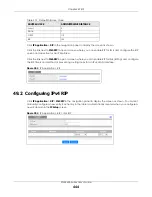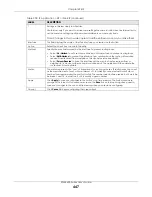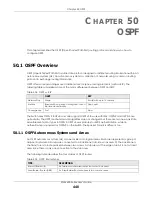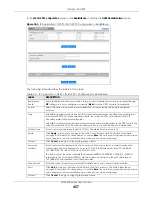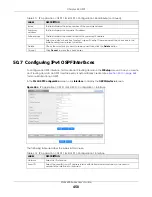
Chapter 49 RIP
XGS4600 Series User’s Guide
443
C
HAPTER
49
RIP
This chapter shows you how to configure RIP (Routing Information Protocol).
49.1 RIP Overview
RIP (Routing Information Protocol) allows a routing device to exchange routing information with other
routers. The
Direction
field controls the sending and receiving of RIP packets. When set to:
•
Both
– the Switch will broadcast its routing table periodically and incorporate the RIP information that
it receives.
•
Incoming
–
the Switch will not send any RIP packets but will accept all RIP packets received.
•
Outgoing
–
the Switch will send out RIP packets but will not accept any RIP packets received.
•
None
– the Switch will not send any RIP packets and will ignore any RIP packets received.
The
Version
field controls the format and the broadcasting method of the RIP packets that the Switch
sends (it recognizes both formats when receiving).
RIP-1
is universally supported; but RIP-2 carries more
information.
RIP-1
is probably adequate for most networks, unless you have an unusual network
topology.
Both
RIP-2B
and
RIP-2M
send the routing data in RIP-2 format; the difference being that
RIP-2B
uses
subnet broadcasting while
RIP-2M
uses multicasting.
The Switch also supports RIPng (RIP next generation) for IPv6. RIPv2 uses UDP port 520 and the multicast
address 224.0.0.9, while RIPng uses UDP port 521 and the multicast address FF02::9.
49.1.1 Administrative Distance
When two or more than two different routing protocols, such as RIP and OSPF provide multiple routes to
the same destination, the Switch can use the administrative distance of the route to determine which
routing protocol to use and add the route to the routing table.
The lower the administrative distance value is, the more preferable the routing protocol is. If two routes
have the same administrative distance value, the Switch uses the route that has the lowest metric value.
The following table lists the default administrative distance value of the route sources supported on the
Switch.
Содержание XGS4600 Series
Страница 24: ...24 PART I User s Guide ...
Страница 44: ...44 PART II Technical Reference ...
Страница 180: ...Chapter 13 Spanning Tree Protocol XGS4600 Series User s Guide 180 Figure 145 MSTP and Legacy RSTP Network Example ...
Страница 189: ...Chapter 16 Mirroring XGS4600 Series User s Guide 189 Figure 150 Advanced Application Mirroring Standalone Mode ...
Страница 244: ...Chapter 22 Policy Rule XGS4600 Series User s Guide 244 Figure 189 Policy Example EXAMPLE ...
Страница 277: ...Chapter 25 Multicast XGS4600 Series User s Guide 277 Figure 215 Advanced Application Multicast MVR Standalone Mode ...
Страница 559: ...Chapter 59 Access Control XGS4600 Series User s Guide 559 Figure 460 Example Lock Denoting a Secure Connection EXAMPLE ...
Страница 586: ...Chapter 69 Configure Clone XGS4600 Series User s Guide 586 Figure 479 Management Configure Clone Standalone Mode ...
Страница 587: ...Chapter 69 Configure Clone XGS4600 Series User s Guide 587 Figure 480 Management Configure Clone Stacking Mode ...
Страница 594: ...Chapter 71 Port Status XGS4600 Series User s Guide 594 Figure 485 Management Port Status Port Details Standalone Mode ...
Страница 604: ...604 PART III Troubleshooting and Appendices ...
















